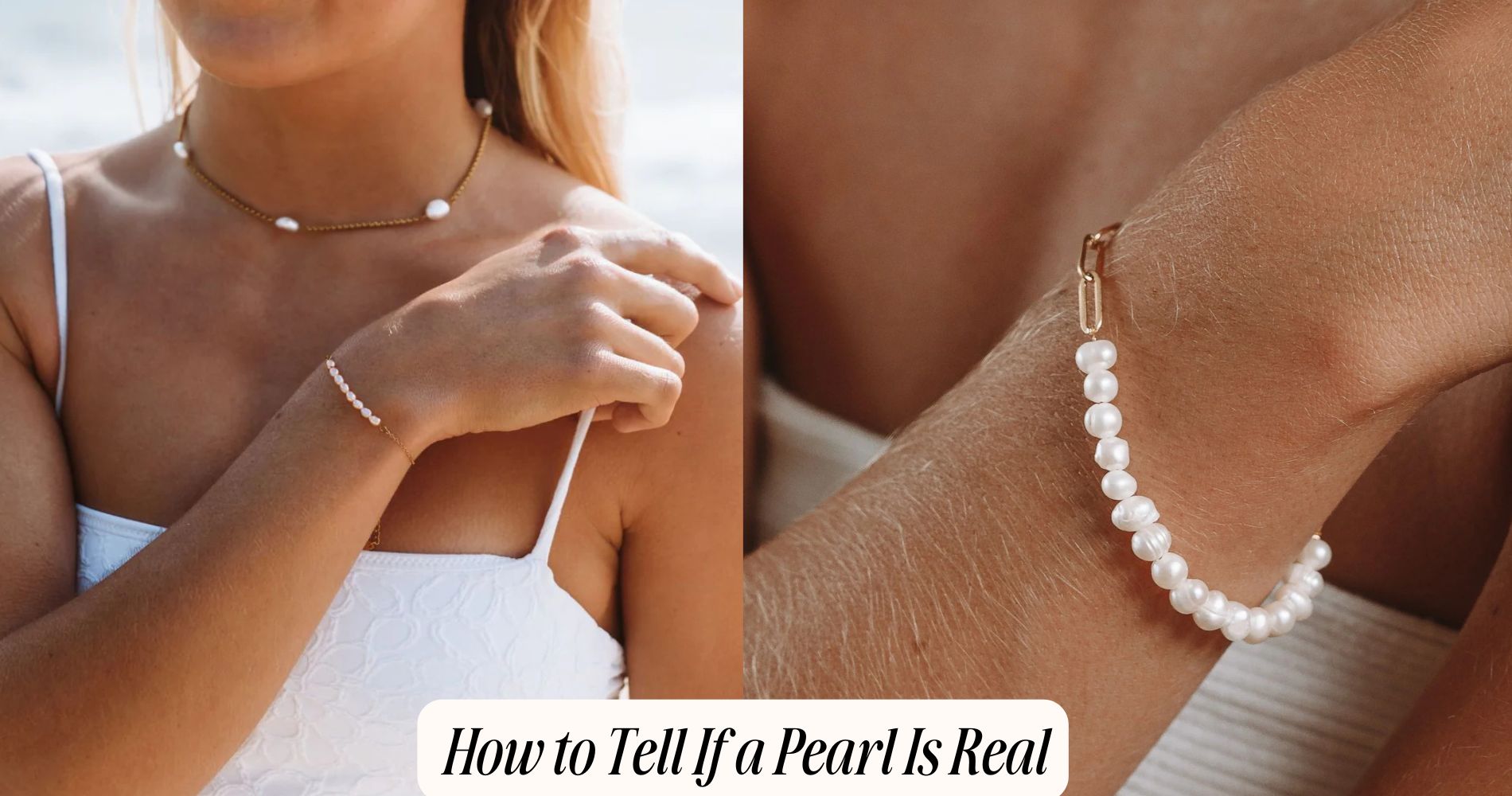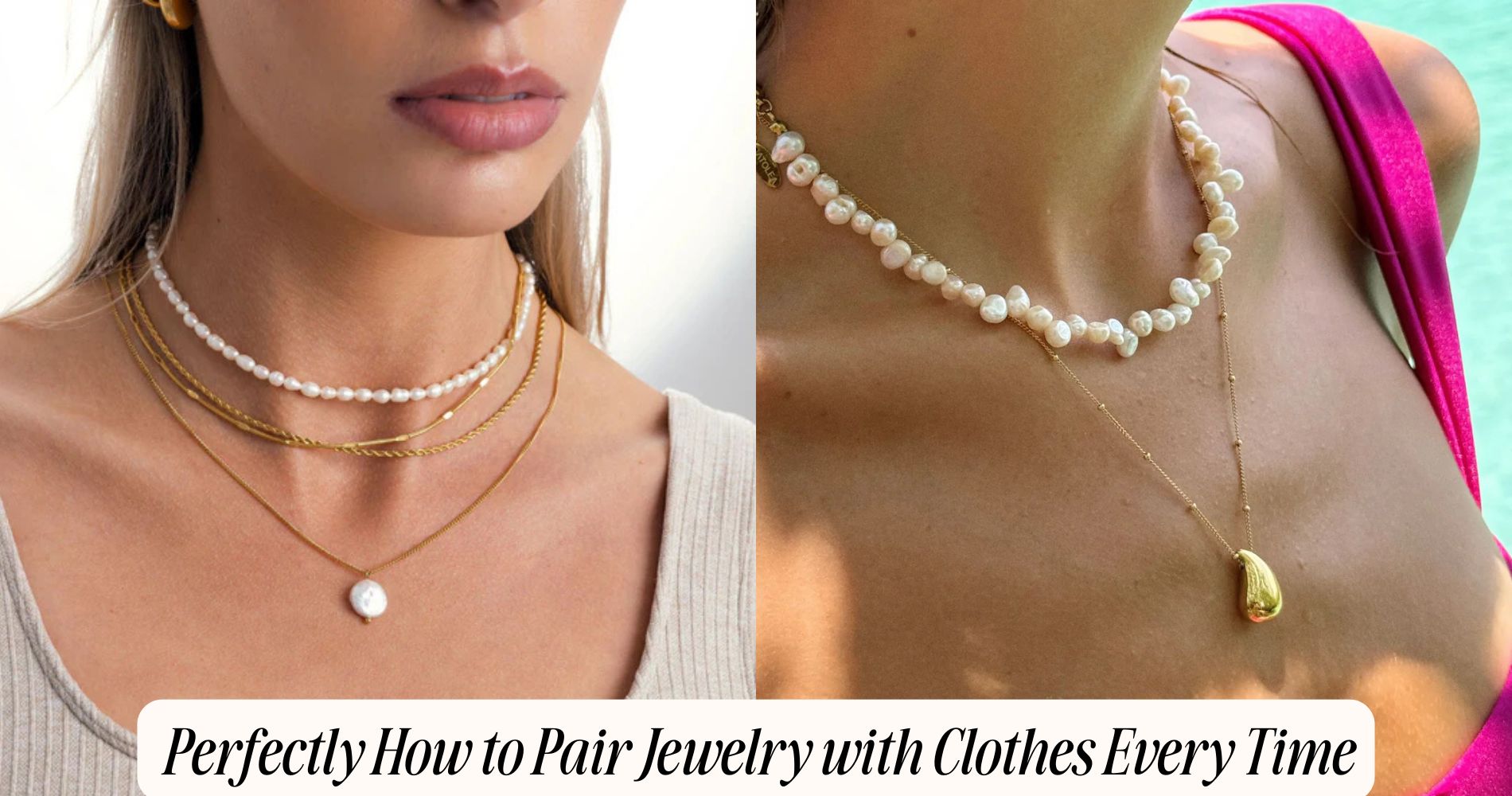
How to Tell If a Pearl Is Real
Learning how to tell if a pearl is real can be as simple as observing a few key features. Start with the surface texture; genuine pearls have subtle bumps and ridges, while imitation pearls are smooth. Next, examine the luster—real pearls give off a soft, radiant glow rather than an overly shiny appearance. The 'tooth test' can also help: rub the pearl against your teeth; authentic pearls feel gritty, while fakes feel smooth. Real pearls are typically heavier, with a nacre thickness that enhances their glow. Finally, look at the drill hole for irregularities, a sign of authenticity. These tips, along with pieces from our Bridesmaid Pearl Bracelet collection, make it easier to distinguish real pearls from imitations.
Examine the Surface Texture
When you examine the surface texture of a pearl, you're looking for key characteristics that can reveal its authenticity. Real pearls, originating from natural or cultured sources, possess distinctive textures that synthetic counterparts lack.
Begin by inspecting the surface for irregularities; genuine pearls often display subtle bumps and ridges, a reflection of their organic formation process. The history and pearl origins contribute to these variations, as each pearl's journey through the water affects its development.
To further assess authenticity, focus on the nacre. High-quality pearls showcase layers of nacre that appear slightly uneven, while imitation pearls typically have a smooth, glassy surface. This historical significance is crucial; pearls have been treasured for centuries, with each unique texture telling a story of its formation in the depths of the ocean.
You should also pay attention to the overall feel of the pearl. Authentic pearls have a slightly cool touch, a characteristic that synthetic materials don't replicate.
Check the Luster and Shine
To determine the authenticity of a pearl, you must closely examine its luster and shine.
Real pearls exhibit a deep, rich color with a reflective quality that enhances their beauty, while imitation pearls often lack this depth and variability.
Additionally, evaluating the nacre thickness is essential, as genuine pearls possess a substantial layer that contributes to their overall luster.
Surface Reflection Quality
A genuine pearl's luster and shine are essential indicators of its authenticity. When examining a pearl, you should closely scrutinize its surface reflection quality. Natural pearls undergo a complex pearl formation process, which results in layers of nacre that create depth and brilliance.
The surface of a real pearl should exhibit a soft, radiant glow rather than a harsh, plastic-like shine. To verify authenticity, observe how light interacts with the pearl. A real pearl will reflect light in a subtle, nuanced manner, producing an iridescent quality. If the pearl seems overly shiny or has a mirrored effect, it's likely a synthetic imitation.
Check for variations in reflection; authentic pearls tend to have slight inconsistencies, reflecting their organic nature. Additionally, you can perform a simple test by rubbing the pearl against your teeth. Genuine pearls feel slightly gritty, while fake ones feel smooth and slippery.
This tactile experience further aids in authenticity verification. Remember, when evaluating a pearl, focus on the quality of its surface reflection; it's a key factor in determining whether you're looking at a true gem or an imitation.
Color Depth and Variability
Color depth and variability play an essential role in evaluating the authenticity of a pearl. When you examine a pearl, the presence of rich color variations and the depth of its hues can indicate whether it's genuine. Real pearls often exhibit a spectrum of natural hues, such as pinks, blues, greens, and creams. These colors aren't uniform; instead, they showcase subtle shifts that add to the complexity of the pearl's appearance.
To assess a pearl's authenticity, observe how the colors interplay with light. Authentic pearls tend to reflect light in a way that enhances their color depth, creating an alluring, almost iridescent quality. If you notice a flat, monochromatic appearance, it could be a sign that the pearl isn't genuine.
Additionally, consider the presence of overtones—these are secondary colors that enhance the primary hue. Real pearls will often display these overtones, contributing to their depth and variability.
Nacre Thickness Assessment
Luster and shine are critical indicators of a pearl's authenticity, closely linked to the thickness of the nacre that forms its outer layer. When you examine a pearl, pay attention to the depth of its luster. A genuine pearl boasts a rich, shimmering glow that results from several layers of nacre formation, built up over time during pearl cultivation.
Thin nacre, often found in imitation pearls, can lead to a dull appearance, lacking the vibrant shine of authentic gems. To assess nacre thickness, observe the pearl's surface and look for a deep, reflective quality. If the shine appears flat or lacks dimension, it's likely a sign of inadequate nacre layers.
You can also perform a simple scratch test on the surface. Real pearls are hard and won't scratch easily, while a poorly made imitation may show marks.
In addition, consider the overall weight; genuine pearls tend to feel heavier due to their nacre density.
Conduct the Tooth Test
To determine the authenticity of a pearl, one effective method you can employ is the tooth test. This simple yet revealing technique involves using your teeth to perform a tooth comparison with the pearl in question.
Take a pearl and gently rub it against your front teeth. A real pearl will feel gritty or slightly textured, owing to its natural nacre layers. In contrast, a fake pearl—often made of plastic or glass—will feel smooth and slippery.
The reason behind this distinction lies in the material composition. Real pearls develop from layers of nacre, which can cause enamel wear over time if they come into contact with your teeth.
If you notice that your teeth feel a slight abrasion or grittiness during the test, it's a good sign that the pearl is genuine. However, if you feel nothing but smoothness, it's likely an imitation.
Keep in mind that while this test can be quite effective, it's best to combine it with other methods for a more accurate assessment of your pearl's authenticity.
Trust your instincts, but also consider seeking the opinion of a professional jeweler for a definitive evaluation.
Assess the Weight and Size
To assess whether your pearl is genuine, start by comparing its weight and size with similar objects.
A real pearl typically feels heavier than a fake one of the same size due to its density.
Additionally, measuring the diameter can help you determine if it falls within the expected range for natural pearls, which often vary in size.
Compare With Similar Objects
When evaluating a pearl's authenticity, comparing it with similar objects can provide valuable insights, particularly regarding weight and size.
Real pearls, especially those with reputable pearl origins, tend to exhibit a certain heft that imitation pearls often lack. For instance, if you have a cultured pearl to compare, hold both in your hand; the real pearl should feel denser and more substantial than synthetic alternatives, which are usually lighter.
Additionally, the size of pearls can vary considerably based on their type. A Tahitian pearl, for instance, generally ranges from 8 to 14mm, while Akoya pearls typically measure between 6 to 9mm.
Knowing these averages helps you gauge whether your pearl aligns with expected dimensions, which can affect its market value. If it seems unusually large or small for its type, that's a red flag.
Measure Diameter and Density
After comparing your pearl with similar objects, you can gain further insights by measuring its diameter and density. Real pearls, formed through natural processes in mollusks, typically exhibit unique characteristics when it comes to size and weight.
Begin by using a caliper or ruler to measure the diameter in millimeters. Most genuine pearls will range from 5 to 20 millimeters, depending on their type and origin.
Next, assess the pearl's density. Real pearls have a density of about 2.7 grams per cubic centimeter, while imitation pearls often fall below this mark. To measure density, weigh the pearl on a precise scale, then calculate its volume by submerging it in water and measuring the displaced volume.
Remember that historical significance plays a role in the context of these measurements. Pearls have been treasured for centuries, with their size contributing to their value and desirability.
Look for Matching Pearls
How can you determine if a strand of pearls is genuine? One essential aspect to examine is whether the pearls are matching types. Authentic pearl strands usually feature pearls that share similar characteristics, including size, shape, color, and luster.
If you notice significant discrepancies among the pearls, it may indicate that the strand is composed of imitation pearls or pearls from different sources.
Pay attention to the grading systems used in the jewelry industry. Genuine pearls often undergo grading based on their quality and uniformity. For instance, AAA-grade pearls are nearly flawless and exhibit excellent luster, while A-grade pearls may show noticeable imperfections.
If the pearls in your strand don't adhere to a consistent grading system, it's a red flag.
When inspecting a strand, hold it up to natural light to better assess the uniformity of the pearls. A genuine strand will reflect light evenly across all pearls, enhancing their beauty.
In contrast, mismatched pearls may create an uneven appearance. By focusing on matching types and adhering to established grading systems, you can make a more informed decision about the authenticity of the pearls you're considering.
Verify the Drill Hole Characteristics
To determine the authenticity of pearls in a strand, examining the drill hole characteristics can provide valuable insights.
When evaluating pearls, focus on the drill holes' appearance and texture. Real pearls typically show irregularities around the drill hole, which reflects their organic nature, as they're formed by living mollusks.
Look for a smooth, polished hole; this may indicate a faux pearl. Additionally, authentic pearls often have a slight roughness or unevenness surrounding the hole, a telltale sign of natural formation.
If you notice a perfectly round and uniform hole, it's likely an authenticity indicator of imitation materials, as these are often drilled with precision machinery.
Another vital aspect is the size of the drill hole. Real pearls generally have smaller holes compared to their synthetic counterparts, which tend to be larger to accommodate mass production methods.
Frequently Asked Questions
Can Real Pearls Be Found in Different Colors?
Yes, you can find pearls in various colors, including white, pink, black, and gold. Each color carries significance; for instance, black pearls symbolize mystery, while pink pearls represent love. These pearl color variations enhance their uniqueness and value.
How Can I Tell the Age of a Pearl?
To determine a pearl's age, examine its luster and layers. Older pearls often display deeper, richer luster due to prolonged pearl formation. The thickness of nacre layers can also indicate age, revealing its history.
What Are the Common Types of Real Pearls?
You'll find two common types of real pearls: freshwater pearls, which are cultivated in lakes and rivers, and saltwater pearls, formed in oceans. Each type showcases unique characteristics, making them distinct in appearance and value.
Conclusion
By following these steps, you can confidently determine the authenticity of a pearl. Examining surface texture, luster, weight, and drill hole characteristics will enhance your ability to identify real pearls. Remember, subtle differences can reveal a lot, especially when comparing pearls for consistency. Whether you're a collector or simply looking to make a purchase, being knowledgeable about these key indicators empowers you to make informed decisions, ensuring your investment in pearls is both wise and rewarding.

























Leave a comment
This site is protected by hCaptcha and the hCaptcha Privacy Policy and Terms of Service apply.